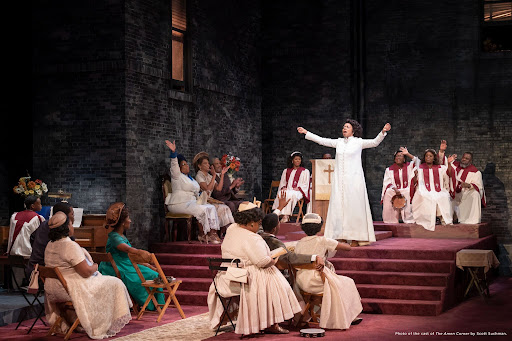Witness the Shakespeare Theatre Company’s The Amen Corner

Image courtesy of the Shakespeare Theatre Company
By Anna Sheehan
Before the lights even came up, the stage of The Amen Corner struck the eye with a powerful symbol: the pulpit. Elevated on a platform center stage, the pulpit glowed under a spotlight while the rest of the set remained shrouded in hazy darkness until the show began.
This was the Shakespeare Theatre Company’s performance of James Baldmwin’s play The Amen Corner. The Company performed the same play in 2020 but had to shut down the show due to Covid. This is the first live production the STC has put on since March 2020, now with a new cast.
The pulpit continued to dominate the set since all set pieces remained stationary throughout the show. Even while the audience watched the story move to the preacher’s home, the audience could also see the inside of the church. The continuity of the pulpit reminded the audience: no matter what other spheres the characters find themselves in, they are first and foremost a congregation. Most especially, the preacher must choose her work as a preacher before she chooses to act as anything else.
The Amen Corner told the fictional story of Sister Maragaret Alexander (Mia Ellis): preacher, mother, friend, and, once the show continues, wife. The show opens in a Harlem church service with a rousing Gospel choir song, which is followed by Margaret’s first sermon, full of call-and-response “Amens” from the congregation. Then more singing and dancing resounds throughout the auditorium.
However, not long after Margaret speaks boldly against people taking jobs in the liquor industry and earns the “Amens” of her church sisters and brothers, Margaret returns home to find she does not have control over her own son’s life. Eighteen-year-old David (Antonio Michael Woodard) hides his whereabouts from the night before and resists his mother’s pleas to accompany her on a church mission. Instead, he wants to stay in the city to perform at his music school with his friends. Minutes after Maragret commanded a loyal congregation as a preacher in a white robe, she is a single mom trying to handle her teenage son.
The tension of Margaret’s multiple roles only builds throughout the show. When her estranged husband and David’s father, Luke (Chiké Johnson), unexpectedly returns, he inspires David to take his musical skills on the road instead of only playing piano for the church. Then, Luke aims to draw Margaret out of her immaculate preacher persona and reignite their former passionate relationship.
It takes Luke’s nearing death and the loss of the loyalty of the congregation for Margaret to acknowledge her humanity. She admits her lingering grief over a tragedy in her past and realizes she still harbors a deep love for Luke. By three-quarters of the way through the show, Margaret’s sister — and the audience — witness her break into tears and make what she believes is the ultimate statement of failure: she cannot pray.
This moment and the previous scene when David tells his mother he will leave home mark the most emotional and raw parts of the play. Margaret becomes vulnerable, revealing that she fled to strict religious practices and the power of being a preacher largely to cope with her past pains. David becomes completely honest, telling his mother how much he loves her and yet how much he needs to free himself from her stifling expectations.
David wants it all; he wants to claim his own identity and to show his love to his family. Woodard’s masterful portrayal of this honest opening up and Ellis’ heartbreaking performance of Margaret’s subsequent breakdown make the play no longer feel like a theatrical production, but live footage of real people struggling to navigate through their lives.
The Amen Corner can also be viewed in the context of race and Black representation in literature. Written by African-American author and activist James Baldwin, the 1953 play offers a lens through which to see a Black church community at a pivotal moment in the history of race in America. However, The Amen Corner stands out not simply for the representation of black lives, but for representing Black people as more than just their Black identity.
With its all-Black cast, The Amen Corner does not focus on the struggle of Black characters against people of other races. Instead, these characters struggle with the role of faith in their lives, falling-outs within families, and tensions between an eighteen-year-old trying to stay true to his parents and become his own person. These are problems people of all races, places, and time periods deal with. The characters of The Amen Corner do not present the audience with their racial profile alone but with the whole of their humanity.
The Shakespeare Theatre Company’s The Amen Corner is running at the Sidney Harman Hall until September 26. Tickets are available online for The Amen Corner and the Shakespeare Theatre Company’s many upcoming shows and events. Discounts are available for students.





